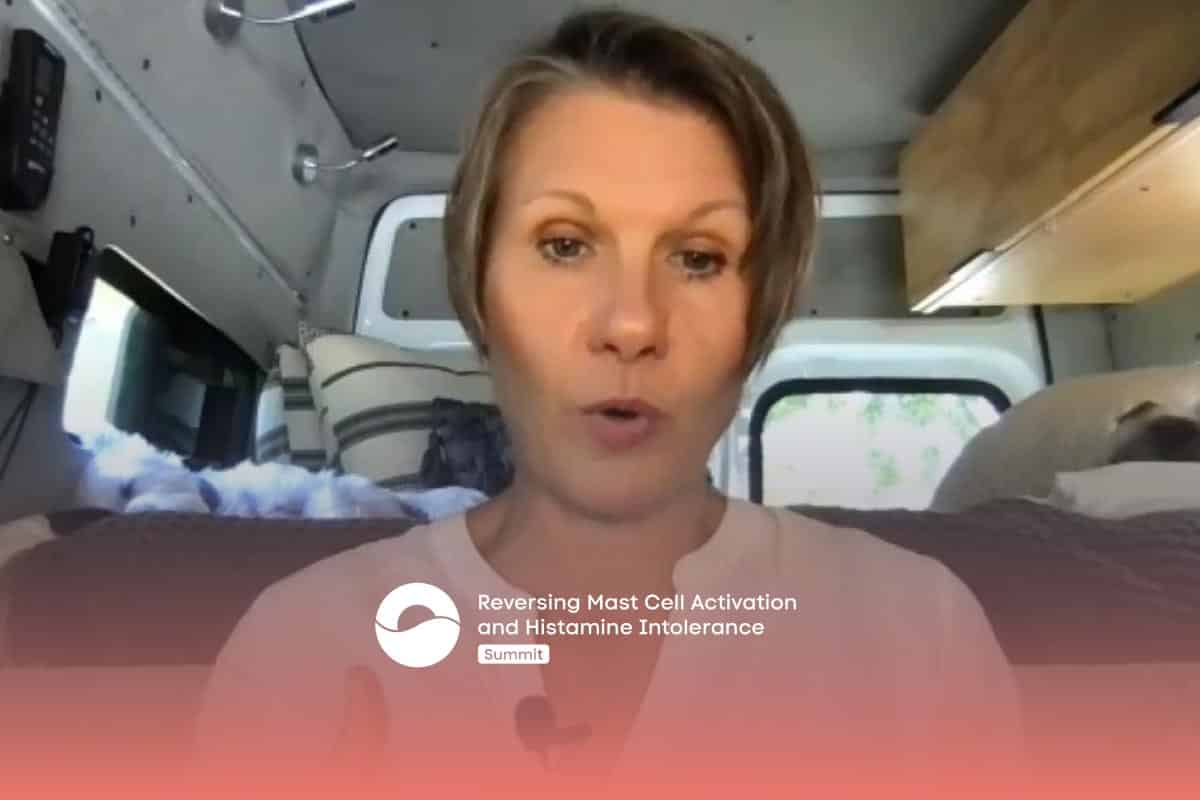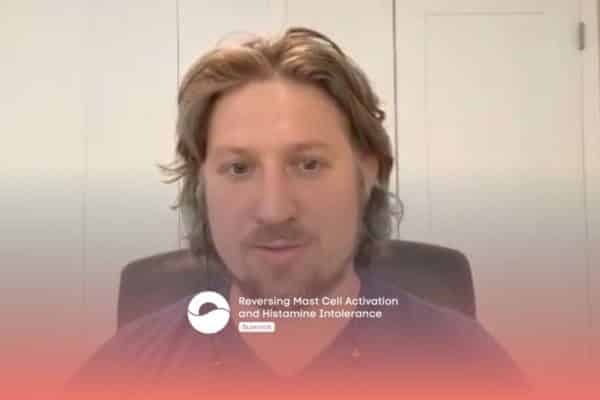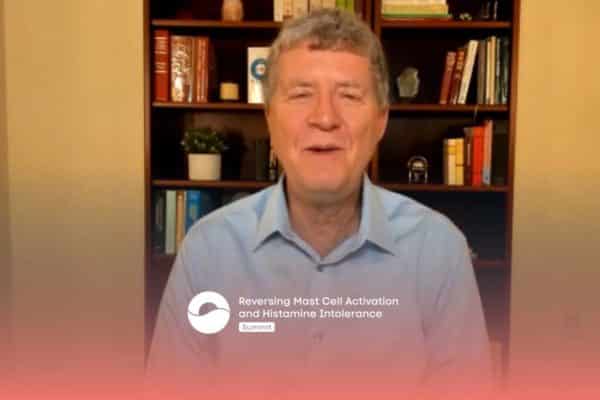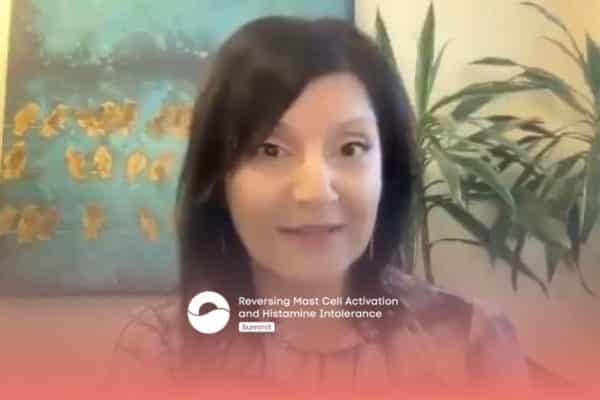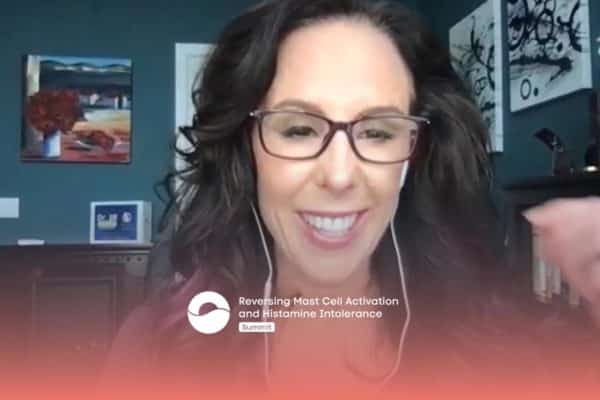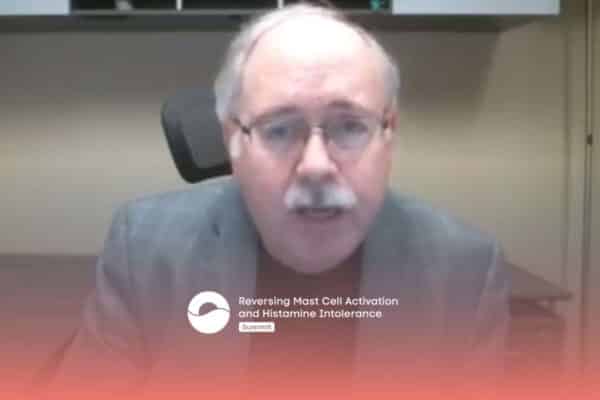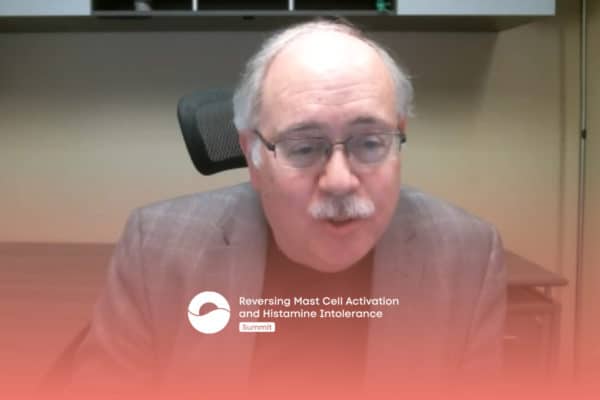Join the discussion below

Beth O’Hara is a Functional Naturopath, specializing in complex, chronic cases of Mast Cell Activation Syndrome, Histamine Intolerance, and Mold Toxicity. She is the founder and owner of Mast Cell 360, a Functional Naturopathy Practice designed to look at all factors surrounding health conditions – genetic, epigenetic, biochemical, physiological, environmental,... Read More
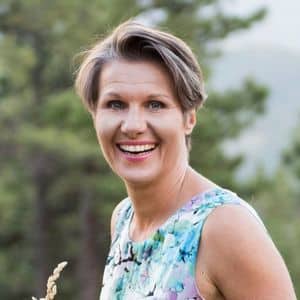
Magdalena Wszelaki is the founder of Hormones Balance community and Wellena products - supplements made by women, for women. Her online platform and products are dedicated to helping women to balance hormones naturally. Magdalena is an endocrine nutrition expert, certified herbalist, speaker, educator and a published author with a long... Read More
- The 3 types of estrogen dominance
- The lesser known symptoms found in both men and women
- How to simplify addressing common triggers
Related Topics
Anxiety, Autoimmune Disease, Breast Health, Cancer, Endometriosis, Estrogen Dominance, Fat Distribution, Hair Loss, Histamine-estrogen Connection, Hormone Health, Hormone Imbalance, Mast Cell Activation, Mood Swings, Period Irregularity, Pms, Thyroid Disorders, Water Retention, Womens HealthBeth O’ Hara, FN
Welcome back to the Reversing Mast Cell Activation and Histamine Intolerance Summit. I’m your host Beth O’Hara of Mast Cell 360. And I have with us today a really special guest, not only my dear friend and colleague Magdalena Wszelaki but also the founder of Hormones Balance community, and Wellena products. These are supplements made by women for women. And I wanna tell you a little bit about her, and then we’re gonna be talking about a really important area, estrogen dominance. And I see that affecting so many people dealing with mast cell activation, and particularly mold toxins, because some of those are highly estrogenic. I wanna share a little bit more about Magdalena and then we’ll bring her on. So her online platform and products are dedicated to helping women balance hormones naturally. And Magdalena is a hormone nutrition expert, certified herbalist, that’s one of our favorite things to geek out on. Speaker, educator and a published author with a long history of her own hormonal challenges, which included both Grave’s and Hashimoto’s, two different types of thyroid autoimmune conditions, as well as estrogen dominance. But today, fortunately she’s in full remission and while sailing through perimenopause, she teaches women how to make this so much easier for themselves. Welcome Magdalena, it’s so good to have you with us.
Magdalena Wszelaki
Thank you very much. And thank you for thinking of hormones when it comes to histamine issues and mast cell activation.
Beth O’ Hara, FN
Absolutely, it’s a big one. It’s one that we look at for nearly all the women that come through our practice. And I know you have your own story. Can you share with the people in our community about what happened in your own health and how you got into this. ‘Cause you didn’t start in the health field.
Magdalena Wszelaki
Yeah, so the thyroid wasn’t as much of a choice. I mean, my thyroid just collapsed and I had to figure out what the heck is going on, and how do I reverse it. So, in my late 20s, I most likely had Grave’s, I had hyperthyroidism, I was put on beta blockers and was told that everything was gonna be dandy. Seven years later, I’ve got another autoimmune disease. This time around Hashimoto’s. So graves makes you hyperthyroid, Hashimoto’s makes you hypo, meaning it slows down the thyroid function. So I needed to figure out what do I do to start feeling like myself again? And so that was the first thing. And then as I got my thyroid under, and the autoimmune component, actually, ’cause the thyroid is really the secondary right to this autoimmune disease is really treating auto immunity that’s more important in the case of Hashimoto’s or Grave’s disease. And when I got that under pretty good control I still felt like my hormones were not very balanced. And in my specific case, I still had hair loss going on. At the same time, my thyroid wasn’t in a really good place.
My antibodies were very low. So I was really puzzled of what was going on. And I was really lucky to find a physician who said, “Let’s test your estrogen.” And so metabolites of estrogen and she concluded I had estrogen dominance. And that was causing my hair loss and suddenly everything started making sense because then I realized, “Oh my gosh!” Not only have I had that my entire life, things like terrible PMSs and a lot of girls have PMS, but it’s a different story when you can’t go to school for a day or two, when you are in fetal position at home with a hot water bottle and painkillers on your side of the bed and telling your parents, you really got a terrible PMS and they don’t know whether you’re trying to skip school or are you truly in terrible pain. Later I started having things like thyroid nodules, which is also one of the symptoms of estrogen dominance. And the worst one was started finding lumps around my breast. And I think for any woman who finds a lump on her breast is one of the scariest moments, because you just, I mean, your whole world starts going wild, is it a cancer or feelings of fear and guilt and then confusion about how do you get it properly diagnosed.
But beyond all of that, when I started looking at all my family issues, I don’t have an aunt who passes the age of 50, who would not have had a hysterectomy. We have a poignant history of ulcers and estrogenic cancers, specifically uterine, ovarian cancers and breast cancers in both sides of my family. And guess what? Later, when I did my genetic testing, turns out that I’m a terrible estrogen metabolizer, which explains why I’m much more predisposed towards estrogen dominance and why both sides of my family have seen women dying of estrogenic cancers. That’s really what piqued my interest of why are we really not, first of all, why is this so normal to have estrogen dominance? Why are we not addressing that? And then also the realization, I remember reading the statistics that most of breast cancers in developed countries are due to estrogen receptor positive, or progesterone receptor positive. And yet it’s completely preventable. It’s totally manageable. And yet we say, “We don’t know the causes.” And we kind of accept estrogen dominance in women, even pre-cancer to be normal. And I thought it wasn’t normal and that wasn’t okay and there wasn’t enough conversation around it. And so that’s the reason why I really started pivoting and focusing my entire attention on estrogen dominance in my practice and with the stuff that we do.
Beth O’ Hara, FN
And fortunately you’re doing so well today. I know that you’re on this fun cross country trip and I got to see you a few months ago. I know you wanted to share why you’re in your camper van here.
Magdalena Wszelaki
Well, I just wanted people to be, people go like, “What is this weird setup with these dogs in the background? Like where is she?” Sometimes when I get on a call, people go like, “Is this a screen saver? Or are you like on a flight or something? Are you in a private jet?” I’m like, no! I’m not that level yet. Yeah, so we met at the Botanical Medicine Conference in Asheville or outside of Asheville in May. So that was very fun. And I just decided that to drive there from Colorado, and then I’m just doing, I’m going all the way up, east coast and I’m in Vermont right now, I’m gonna see the change of seasons here and then I’m gonna be heading down back to Colorado. So it’s a five month trip. As an herbalist too and I love botany, Colorado is somewhat limited because of the elevation, we’re on a high desert, so the kind of botany that we get to see on the east coast fascinates me. So it’s partly exploration, partly just my nomadic nature. And I’m living out of my camper van, I’m working out of my camper van. So yeah, it’s been great overall.
Beth O’ Hara, FN
And I just love that your health is at a point now that you can do this big adventure and it’s so inspiring, I think to see people get their health back and then do these dream kind of things that they wanted to do for so long. Well, now we’re gonna dive more into estrogen dominance. Why don’t we just, I know a lot of people have heard that phrase, but why don’t we just start by defining it? And then what are the symptoms that people should really be looking for? And I know men can be estrogen dominant as well.
Magdalena Wszelaki
Yeah, yeah. Let’s talk about that. So let’s start off with symptoms. Estrogen dominance can manifest in the most common ways for women who are still menstruating will be having terrible PMSs, PMDD, but also period irregularity, so if you talk about having too heavy of a period, heavy irregular periods, having a lack of periods, having terribly painful periods, that all can be, all of that is a lot of the time connected to estrogen dominance. Women with endometriosis, however, endometriosis also has an inflammatory and autoimmune component to it, but estrogen, or guess what estrogen also fuels inflammation. Women having a lot of our breast health is correlated with levels of estrogen. So for example, having cyst on the breast, having fibrocystic breast, some women get so enlarged and have such painful breasts, they can’t even put on a bra or do any sports, during when they’re cycling and so before their periods. Other things, interestingly like where we store fat in our body can be indicative of what kind of a hormonal imbalance we have. So women who are typical pear shapes, and I’m certainly one of them, if I put on weight, it’s all gonna go in my butt and my thighs.
And that’s your typical estrogenic kind of a woman. With a predisposition to be estrogen dominant, we store a lot of fat in the thighs, butts and largely there versus women who have more of a metabolic issues, with blood sugar imbalance or having too much testosterone, all of that goes into their belly, so they’re more of the apple type. And that’s important to know because a lot of times women hit up the gym like five, six days a week, trying to lose that cellulite or fat around their thighs and butts, and it’s just not budging, and it could be because you’re just not resolving estrogen dominance as an underlying cause. Thyroids, actually, a lot of different cancers are estrogenic, so thyroid cancer is one in that category as well. But also thyroid nodules, which so many people experience, also grow due to estrogen. Estrogen is what fuels that growth. Little things like, for example, water retention.
You have a lot of water retention in your fingers, in your legs, it’s hard to put your shoes back on. That can be also due to estrogen dominance. Mood swings, that’s one of the classical thing, anything to do with mental, emotional health. And so how many women’s relationships are on the line because of having hormonal issues. And again, estrogen dominance, it can be fueling that. And so here, we’re talking about things like just super anger, huge anger, huge mood swings. You know very well you’re not the person who is sometimes showing up as like this demon that comes out and then goes away. Women with anxiety, we’re gonna talk about different types of estrogen dominance in just a second, but one of them, the one that is the estrogen-progesterone levels are out of balance will manifest in the form of like having suddenly sleeping problems. You’ve always been a really great sleeper and then suddenly you just can’t sleep anymore. You can’t sleep through the night, you can’t fall asleep. Your brain is racing. Women who’re suddenly having a lot of anxiety around things and again, it could be due to histamine. And we’re gonna talk about the histamine-estrogen connection, but it goes, it can definitely be fueled by estrogen dominance where you suddenly become like, become this warrior as in not warring, but like worrying about things and everything is an issue and a problem.
So those are some of the, I would say most common ones that a lot, well, let me not forget fibroids. So speaking of uterine health, fibroids is one of the classical symptoms as well. And it’s really devastating because about, there’s about 250,000 surgeries every year where women are having surgery, surgical procedure done, a full or partial hysterectomy due to fibroids, and most of them are completely preventable. So that’s another huge one for estrogen dominance. Migraines, a lot of women experience migraines around their cycle. It’s good to know whether the migraine is like showing up just anytime, because that could be more like food related or some nutrient deficiency related, or does it show up around your, just meals before you get your period, that could be that. Women who are in perimenopause and are experiencing mid cycle spotting could be another symptom of the type of estrogen dominance which is due to low progesterone. So, you suddenly have this brown discoloration on your panties in the midst of your cycle instead of ovulating. So that’s another symptom to look out for.
As you can see, hair loss, what I mentioned about my stuff. And the cancer is that, let me just conclude by saying the estrogenic cancers are lung cancers in non-smokers, I mentioned thyroid cancer, but also the classical ones would be estrogen receptor positive breast cancer, which is the majority of cancers in the United States. Ovarian and uterine cancer is all fueled by estrogen. Lastly, you mentioned man, and almost every woman, there is some man in some form or another around us. So interestingly breast cancer in men is actually on the rise and men can also get breast cancer because they do have breasts. And then prostate issues in man, both just and enlarged prostate as well. Prostate cancer are also fueled by estrogen. So as you can see, even as a woman, when you make certain changes to the products that you use in the house or just how you’re eating that will not just help the women in the family but also will affect the guy as well. And most men sleep also way better when they follow the protocol too.
Beth O’ Hara, FN
So many symptoms people don’t normally think about that you’re talking about. The hair loss, the thyroid nodules and the thyroid issues, the thyroid cancers, all of these types of things. So we know that estrogen can also trigger, I wanna bring it to our specialty here, which is the mast cell activation and the histamine intolerance, estrogen dominance is a really big deal in this population. And so many women will get into think, “Oh, well, I’m in menopause. I can’t have estrogen dominance.” Let’s just talk briefly about that issue, specifically estrogen dominant and mast cell and histamine issues.
Magdalena Wszelaki
Yeah, yeah, sure. So they are in a sort of unhealthy relationship with each other. So what happens is mast cell activation, I’ll put it this way, when there’s excess estrogen, we’re gonna talk later how that can happen. And so high estrogen will basically create mast cell. No, it’s the mast cells, sorry, it’s the mast cells that will release histamine, and histamine also stimulates ovaries to produce more estrogen. But also when you’re high in estrogen, you are also creating more histamine. So there is this constant relationship with each other and the question is chicken or egg, what do you fix first? And the cool thing about what you and I do is that there’s a lot of similarities in what we do and by addressing the mast cell activation, you’re also addressing estrogen dominance at the same time. So you don’t really need to do too many things that are very different from each other, but it’s good to know that which one will help.
Beth O’ Hara, FN
Yeah, and really that downward spiral that you’re talking about where the mast cells have these estrogen receptors. So if we’re estrogen dom, we don’t only have to have a high estrogen, we can just be estrogen dominant. Estrogen tends to be mass cell triggering. Progesterone from a lot of people is mast cell calming. Not everybody, but a lot of people. So we need that healthy ratio. But when people are flipped, that’s gonna keep triggering those mast cell receptors, then they’re gonna release a histamine, and then they’ve over a thousand other inflammatory mediators they can release and then that triggers this more estrogen and so on. But there are different types of estrogen dominance. Can we talk about that? How they show up and how people could have low estrogen and still have estrogen dominance?
Magdalena Wszelaki
Yeah, sure. So let’s talk about the two, or just maybe wanna continue to the two different types of estrogen dominance that are, I think, easiest to explain. So the first one is, we are alluded to that, the balance between estrogen and progesterone needs to be in check. So think of it at this way. It’s a little bit like, if you like to watch a dance competition, and you see the woman being like super flamboyant and super dressed and the guy is like timid and kind of the dressed down, it doesn’t look good. And they’re not gonna win any competition. They look unbalanced. And so estrogen and progesterone are exactly like that. They are those two dance partners. They have very different roles in the body. Just as a quick example, it’s a little bit like if you have the grass growing, estrogen is what makes the grass grow, and progesterone is the mower that comes and cuts it. So that’s what happens in the endometrium and that’s why we get our periods, when the progesterone comes and helps to shed it.
So they have this wonderful relationship with each other, but they have to be, there has to be a balance between them. So that’s the first thing that’s gonna happen. And especially for women who are going into menopause and perimenopause, progesterone tends to drop a lot faster than estrogen does. And so that creates quickly an imbalance between those two, but you don’t have to be in perimenopause and menopause to experience that, even women who are still cycling will show signs of low progesterone. The way that can happen is that for example, stress is a huge cause for progesterone robbery. When you have a mother hormone called pregnenolone and pregnenolone is only so much your body’s producing and some of it goes towards cortisol to help you manage the stress, and some of it goes towards progesterone to make you fall asleep and get pregnant and be calm and sleep well. Well, guess what, in times of crisis, the body’s gonna predict, just give everything there is, the pregnenolone to cortisol in order to, for you to survive and thrive. And so not even thrive, just survive and get through the stress. And so robbing you that way of progesterone. So progesterone deficiency is very common where estrogen deficiency. The second type of estrogen dominance which is really important to understand is the way we breakout estrogens is really, really key. So estrogen is not just one hormone, it’s actually a whole composition of hormones. And what’s more important is that in the liver and the gut, the estrogens get broken down to these different metabolites. So it’s a little bit, let’s use this analogy of you’re standing by, I come in Vermont right now. It’s just this beautiful rivers and streams everywhere.
So imagine you’re standing by a river and this river is flowing and it is kind of somewhat of a murky water and there is a bank in the middle of the river bed and that bank separates the water to a clean stream and a dirty stream. And so in the human body, it’s the liver that separates those clean estrogens to dirty estrogens. So the term estrogen dominance is a little bit unfortunate because we tend to demonize estrogens. A lot of women say, “I’m estrogen dominant,” and so everything is, estrogen is a bad hormone. Well, the truth is that you and I will not be here sitting and having a cohesive conversation, our brain’s working, and our skin being the way it is, and having cycles and all of that without having sufficient levels of estrogen. So we need estrogen. The question is how you break them down is important. And so the health of the liver and the gut plays huge role in how those estrogens get broken down to metabolites.
And what I, just for simplicity, I just call it clean estrogens which are beneficial, helpful building versus the dirty estrogens that are pathogenic, that tend to be the contributing ones towards all the symptoms we talked about. The clean estrogens, for example, are now gonna be causing breast cancer. It’s the dirty estrogens that are attaching themselves to cells and do DNA damage to cells and cause proliferation of cancer cells. So just wanna be clear on that. So those are the two types. Estrogen-progesterone balance is one issue. Second one is how you break down those estrogens, think about the river. It’s the second issue.
Beth O’ Hara, FN
And there’s three types of estrogens. I think you can go into that with this group.
Magdalena Wszelaki
Okay. Yeah, sure. So, there is another way to measure, and this was kind of started by the saliva testing companies. And this is a good test to establish through saliva testing. So, number of labs do that and where you can see three different types of estrogens. Estrone is the E1, we call it, estradiol, which is the more aggressive, prevalent estrogen. It’s not a bad estrogen. It’s just, we tend to have too much of it. And then Estriol, which is more protective, highest in pregnant women, but can also be highly protective for women who are towards the later stages of life. So there is a relationship, we call it the estrogen quoting. There is a relationship of the amounts of these estrogens that need to be in place in order for a person to be in a good balance. And so that’s another way of measuring it. I tend not to talk so much about it because you gotta have saliva testing done in order to establish that.
I’m a bigger fan of the first two that I mentioned, because they can be measured through. I don’t know if you wanna get into, maybe we can talk about lab testing later, but yeah, there is different labs that can be ordered in order to establish that. So you mentioned that question, something that a lot of women wonder, “Hey, I’m in menopause or I’m heading for perimenopause. My estrogen is inevitably low. I can feel it, I know it. I shouldn’t even be listening to this talk, ’cause of this estrogen dominance.” In fact, my book “Overcoming Estrogen Dominance,” one of my colleagues had it on her desk and her mom came visiting, and her mom is struggling with menopause. She’s struggling with estrogen dominance. She just had a couple of fibroids removed. And this woman is like in her late fifties, early sixties. And she looked at the book and she put it down, and her daughter, my colleague says, “Mom, you should actually read this book. This is gonna help you with a lot of your conditions.”
She goes, “How so? I’m in menopause. I don’t have any estrogen.” Observation or an assumption, but here’s the thing, first of all, a lot of women say, “I don’t have any estrogen.” That’s incorrect. You would not function and you would not be sitting up straight, listening to this talk if you had no estrogen. You would now have estrogen, it basically declines. But going back to the different types of estrogens, think of it this way, as we age, estrogen starts dropping. However, our progesterone starts dropping even faster than that. So the relationship between the estrogens and the progesterone becomes, or the imbalance between them becomes even more profound and prominent as we go older. And this is especially for women 45 and above, this is where progesterone starts dropping really quickly. So even though your estrogen is low and your progesterone is low, the ratio of those two, it’s still very unbalanced. The other-
Beth O’ Hara, FN
Sorry about that, everyone, with Magdalena being on the road, she’s having some unpredictable bandwidth, so we just turned the cameras off so we can get better audio for you. And we really wanted to get this interview for you guys, because it’s so important. Magdalena, we were just in the middle of talking about how people can be estrogen dominant, even in menopause and you had a few thoughts to finish out there.
Magdalena Wszelaki
Yeah, so absolutely, that’s a very common question, because you think, “Well, I’m in menopause and my estrogen is taking a nose dive. There’s no way I’m gonna be estrogen dominant. That doesn’t relate to me.” In fact, I have a colleague whose mom picked up my book “Overcoming Estrogen Dominance” and she put it down, and my colleague says to her, “No, mom, you should really read it. There’s a lot of things in there that’s gonna really help, this book is gonna help your stuff like your breast issues.” And the mom says, “No way, I’m in menopause. I don’t have an estrogen dominance.” It’s just didn’t make any sense to her and that’s plausible. But here’s the deal, so let me just, remember how we talked about the different types of estrogen? So what is happening, even though your estrogen and your progesterone levels are dropping, there’s two things that can still be happening in spite of that.
One of them is that even though you have low estrogen and you have low progesterone because you’re headed for perimenopause or any menopause, postmenopause even, the ratio between that progesterone and estrogen is still an issue, meaning that you, even though you have low estrogen, it’s still too high compared to progesterone. And one easy way of fixing this is to basically get on bioidentical progesterone. The other way that can still happen and it doesn’t have to be one or the other, by the way, both of them can be happening at the same time. Even though again, your estrogen is low in menopause, the way you’re metabolizing that estrogen into clean and dirty estrogens that I talked about, you’re still producing too many dirty estrogens, and that is very common because our liver plays such a huge role in metabolizing estrogens, in breaking them down. And as we age, our liver is just not as efficient as it used to be. Think about it this way, like in college, for those of you who are just a big partiers and drinkers, you have three, four, maybe five tequilas and go to lectures the next morning, be okay. Try to do it now.
Beth O’ Hara, FN
Not gonna happen.
Magdalena Wszelaki
Oh, exactly. And that’s when plausible explanation, our liver is just not as efficient as it was in our twenties and thirties. And so really, if we have that kind of estrogen dominance, then supporting our liver, which is always a great idea anyway, is gonna correct estrogen dominance in women in perimenopause and menopause. And last thing I just wanna mention on this Beth is this, if you think about it, who are the demographic with the highest number of estrogen receptor positive breast cancers? Women, 45, especially the 65 and above it’s the highest demographic, Do these women have sky rocking estrogens? No! Are they just on women who are on some bioidentical hormones, estrogen? Not necessarily. So their estrogen levels are naturally going down, yet they get estrogen receptor positive breast cancer. So you can see, I think that the breast cancer example just really illustrates how estrogen dominance can be not just present in women in menopause and perimenopause, but it can also be highly detrimental to us at that age too.
Beth O’ Hara, FN
And this has been so important both to me and this community, this conversation about estrogen dominance and cancer risk. And it’s been one of the things alongside dementia and early-onset Alzheimer’s or other neuro-inflammatory conditions that I’ve been very on the watch out for myself and protective of because of the extreme amount of triggers that I’ve had my whole life. And one of the most concerning to me is the mold toxin zearalenone which has been linked with every kind of estrogen, positive cancer, as well as endometriosis, PCOS, and all of this. It acts like an estrogen in body. Much, much stronger, dozens of times stronger than E2 estrogen. What are some of the other most common triggers you see for estrogen dominance in people?
Magdalena Wszelaki
Yeah, so I think the easiest thing to do is to really look at it internally and externally. Internal, external features. External factors will be things like consumption of, for example, so-called conventionally raised animals. So those are cows, those basically that’s meat that’s coming from animals that’s been treated in horrific ways that kind of, if you’re talk about that meat being inflammatory, that’s a kind of meat that is inflammatory.
Beth O’ Hara, FN
Yeah.
Magdalena Wszelaki
So switching to like truly grass fed, grass finished kind of meat, reducing meat, first of all and then also just getting it from really responsible sources, so it doesn’t break your bank is one easy way of doing that. Dairy is a huge source of estrogens as well. Anything that’s, I hate that term conventionally raised vegetables and food, because there’s nothing conventional. I mean, we made it conventional, but why don’t we just call it toxic?
Beth O’ Hara, FN
Right.
Magdalena Wszelaki
There’s so many of the pesticides, the fungicides and all of that that’s being used, the fertilizers that are being used in that kind of agriculture. They’re just screaming. And so again, simple conversion here would be doing organic food as much as possible. And so another thing to look at is skincare products.
Beth O’ Hara, FN
Yeah.
Magdalena Wszelaki
Also, but also your cleaning products in the house. Bathroom, toilet, kitchen, all of that. And one of the, there is in my books, I detail out all the different chemicals that I found in all these kind of products, but here’s the thing, you’re just gonna drive yourself crazy, looking, going to every, looking at every single product and trying to analyze the labels. We don’t want that. And especially of like, I think we have enough issues with our daily life. And so how much more do you wanna micromanage your life? But here is my shortcut to all of this, is that just don’t buy mainstream brands. When I say mainstream brands, like stuff that you see advertised on television, glossy magazines, all these big brands that we all know, just stay away from that stuff. Now, other older organic brands are safe? Mm, not always.
There’s a lot of greenwashing in our industry. So what I have personally found is either follow influencers online who you trust and then buy stuff from online, or the other option is when as I’m on the road, one of the things that I do is I just go to local food co-ops or local health food stores. And the cool thing is that the buyers there, they have a social and community responsibility to providing the cleanest product possible that’s good for people, good for the earth, good for our water, for our soil. I have found that every time I go to a health food store, like I’m in Vermont right now, but as I was traveling, same thing, North Carolina, and in all the different states, they curate these products for you so you don’t have to figure it out and be looking at every single ingredient and drive yourself crazy. And by the way, those ingredients also keep changing. So it’s just like, you’re like playing a cat and mouse game.
Beth O’ Hara, FN
Yeah.
Magdalena Wszelaki
The thing I would just mention here ’cause I made a post about just recently, I watched Dark Waters so that incredible movie based on a true story of DuPont. Your kitchen utensils are, just your pots and pans, can be a huge source of those what we call xenoestrogens, externally found estrogens in all the nonstick pans. And so throw away all the, we don’t have Teflon anymore but we have all the PFOAs and all that. And all the nonstick stuff substitute that with just really clean options and not those green pans and Caraways and which basically they’re using a different kind of a nonstick ingredient that they don’t wanna disclose and to hide behind all sorts of legalities of a secret formula. But you’re really truly going back to what grandmas used to cook with. And that is cast iron, stainless steel. My personal favorite is carbon steel, that’s something that French restaurant chefs are using. And you can, once you season it, you can just Google it, how to season a pan like that?
You do it seven, eight times and it’s ready to go. I use only cast iron, sorry, carbon pans in my kitchen and they’re completely nonstick now, once they’re seasoned. And also my other favorite for pots is basically, so that’s a frying pen, the carbon steel, but for pots, I would use things like made from enamel, sorry, coated in enamel. I like using cast iron that’s coated in enamel. And enamel is basically glass. So this just, simple things like that. So I would say those are like big external sources that you can eliminate pretty quickly and this can be overwhelming. So one of the things that I suggest to do is like, make it a point that every three months you take care of a different part of the house. One month is gonna be like the kitchen, three months later, you save up money, just replace all your cleaning products and you just go by stages so you don’t have to do everything in one go. So I would say that’s like, that’s a big part of what’s going on. In young women, we see estrogen dominance because of being on the pill. So those are synthetic estrogens, hugely problematic. So that’s one big, big thing that it’s definitely recommended to get off birth control pills. If you talk about internally what’s happening, we can be, I can live, I’m a good example of that, where I live the kind of lifestyle where those external xenoestrogens are as limited as I possibly can, but I still tend to be estrogen dominant, because that’s just how genetically I am. So that’s what’s happening on the inside of your body is how you metabolize these estrogens that we talked about.
So that river with that bank, and that bank being your liver. So supporting the liver is just so hugely important and incorporating better herbs, better foods, doing castor oil packs, doing the full elimination diet when you just really get rid of all the inflammatory foods is gonna support the liver in a huge way. So that’s really, that’s how we can support the body. And, the last thing, doing a bit of just reducing stress which is so hugely inflammatory is going to be helping us in a big way to regain that balance between estrogen and progesterone, which is one of the causes of estrogen dominance. So I know it sounds like it’s a lot of stuff, but I also know that a lot of this stuff is what you teach as well in your approach. And so it’s like what we said at the beginning, you don’t have to be doing a lot of things for every single symptom you are experiencing, it’s most likely when you implement the protocols that you teach, you’re probably gonna cover most of mine with it as well.
Beth O’ Hara, FN
And what I love about what you do is just like you’re talking about here, you make it practical and you make it manageable. And some of those things that you try support the liver, that estrogen goes down, we have those phase one pathways, and then the phase two pathways, the same major pathways that detox those mold toxins. And that’s one of the triggers we talk about over and over. So even things like dandelion root tea, I know we had so much fun at the Herbal Conference, just learning about all these uses of dandelion and-
Magdalena Wszelaki
Yeah, we had a whole lecture on it.
Beth O’ Hara, FN
Yeah. And other things like astaxanthin and I know you have some products for supporting these pathways as well. And then to wrap up, Magdalena, there’s a question that I know I hear a lot, I know you hear a whole lot about flaxseed, and is flax okay for women with estrogen dominance?
Magdalena Wszelaki
Yes, and the answer is a resounding yes. So the reason why in case people are wondering why is there potentially an issue? So flaxseed contains natural occurring estrogens, we call it phytoestrogens. They’re very delicate, very gentle estrogens. And remember, like we said at the beginning, estrogen is not a bad hormone. And so flaxseed doesn’t hurt anybody. The issue with it is that the reason why it’s so beneficial is that number one, let’s just face the fact that it is just an incredible source of fiber, both soluble and insoluble fiber, and it’s gonna help you move your bowels, which by the way, constipation is one of the big leading causes of hormonal problems and including estrogen dominance, because you’re recycling the same estrogens instead of pooping them out, everything reenters your body.
So flaxseed is gonna, as fiber, it’s gonna help you regain the bowel movement again. And the second thing is this is totally my own term, but I like to see flaxseed as I call it a real adaptogen, an estrogenic adaptogen, meaning that if somebody’s low on estrogen, say for example, you have hot flashes, by adding flaxseed is gonna most likely help your hot flashes and raise your estrogen levels. But if somebody has estrogen dominance, like for example, terrible PMSs, or is having lumpy breasts and cysts on their breast, estrogen is actually going to step in and block those receptors for dirty estrogens, those dirty metabolites we talked about, and wouldn’t let them through to do the damage. But it will allow the good estrogens to attach themselves to the cells. So it acts like a real adaptogen, depending on what the body needs. It basically supports you where you need it, allowing access for the good estrogens, blocking access to the dirty ones, which is just such a, what a gift from mother nature that is.
Beth O’ Hara, FN
Right. And it’ll bind some of those dirtier estrogens and then one of the things we’ve been alluding to is that we have a protective estrogen called E3. And I think we’re talking about with that adaptogenic response is that that E3 is so protective against these kinds of hormone receptor, estrogen receptor dominant cancers. Well, this has been fascinating. I always learn so much when I talk with you. And I just wanna really thank you for sharing your time and your wisdom, your knowledge with us on the summit. How can people find you? And I want you to tell them about your book, ’cause it’s a mainstay on my desk here and I refer to it a lot.
Magdalena Wszelaki
Yeah, so if you’re on social media, we are on Facebook, hormones with an S, Hormones Balance is the name of the community, on Instagram, as Hormone, without the S, just to make things complicated. And the book that you’re referencing is called “Overcoming Estrogen Dominance” and it’s available on Amazon.
Beth O’ Hara, FN
And then your website, you have some courses.
Magdalena Wszelaki
Oh, sorry. Yeah, so it’s hormones with an S, hormonesbalance.com is the educational site of our practice and wellena.com, W-E-L-L-E-N-A is the website that has all the supplements, including how to address estrogen dominance.
Beth O’ Hara, FN
So we’re gonna link to the book on our summit resources page. I wanna link to your Wellena products. I know some things have some higher histamine ingredients, so people, just check if you’re histamine intolerant, but really amazing products. And one of my favorite is the after bidders and are low histamine. So we’re gonna link to those as well over at mastcell360.com/summit.
Magdalena Wszelaki
Yeah, thank you.
Beth O’ Hara, FN
Well, thank you again so much. I really appreciate all the work that you do in the world. And it’s just a real pleasure to have you on our summit.
Magdalena Wszelaki
Thank you so much for having me.
Downloads

